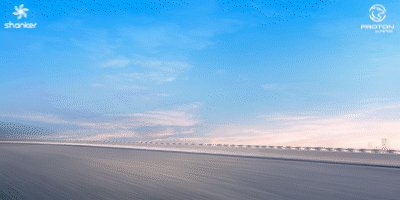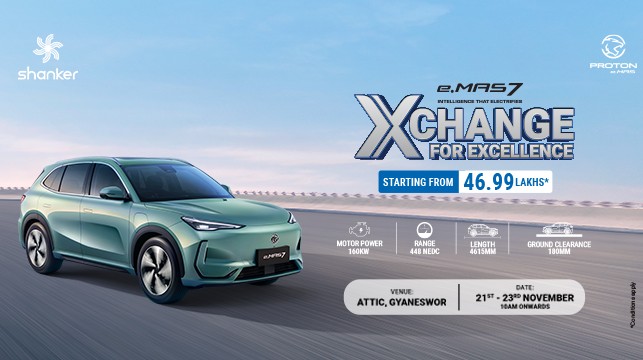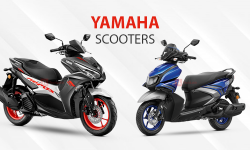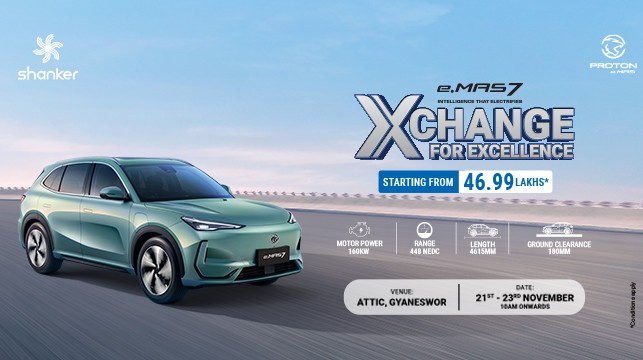HIGHLIGHTS
- Ather Rizta price in Nepal is Rs. 3.84 Lakhs.
- It is designed as a family-focused electric scooter.
- Rizta is available in the top variant with a 4.2 kW Motor and a 3.7 kWh Battery configuration.
After seven years perfecting its performance-focused 450 series, Ather Energy has stepped into new territory with its first family-oriented electric scooter without the “450” name. The Ather Rizta was recently launched at the NAIMA Nepal Mobility Expo 2025, marking a calculated move to expand the reach beyond its traditional performance segment.

Vaidya Energy, the authorized distributor of Ather scooters in Nepal, has launched what could be Ather’s most accessible and mass-appealing product yet. The Rizta marks a strategic shift for the brand, i.e., from niche performance to mainstream family utility.
And it’s a shift that has already paid off handsomely in India. Launched in one of the world’s most competitive scooter markets, the Ather Rizta quickly turned into a runaway success. It crossed the 1 lakh sales milestone within its first year, and today, it contributes to nearly 60% of Ather’s total sales, which, in short, is a staggering achievement for a company once laser-focused on the 450X and its kin.
In hindsight, Ather may well wonder why they didn’t make this move sooner. The demand was there. And now, it’s Nepal’s turn!
What is the Price of Ather Rizta in Nepal?
The Ather Rizta price in Nepal is Rs. 3.84 Lakhs.
In India, the Ather Rizta is sold in four variants based on two battery sizes: 2.9 kWh and 3.7 kWh, each available in S and Z trims. For Nepal, Ather has kept it simple. We only get one version, the fully loaded Rizta Z with the larger 3.7 kWh battery.
That choice explains the steeper price tag. The bigger battery not only boosts the claimed range to 159 km (IDC) but also improves charging times. In real-world terms, the Z trim delivers a 125 km True Range and comes with a 700W Ather Duo Charger that tops it up in 5 hours and 45 minutes. In comparison, the lower S trim offers 100 km of True Range and comes with a 350W Portable Charger that needs 8 hours and 30 minutes for a full charge.
We expected Ather Nepal to position the Rizta somewhere between the 450S and the 450X 2.9 kWh. Instead, they’ve gone all-in, placing it as a family-focused counterpart to the flagship 450X 3.7 kWh. That also means any upcoming family electric scooter in Nepal will now have to match the very best Ather has on offer.
To sweeten the deal, the Rizta Z includes a 5-year/60,000 km Battery Warranty, a 3-year/30,000 km Vehicle Warranty, and a 3-year Charger Warranty. Buyers who pay in full can even extend the battery warranty coverage to 8 years!
With that said, let’s take a quick look at the key specifications of Ather Rizta in Nepal for 2025.
Ather Rizta Z Specifications
- Motor: 4.3 kW Permanent Magnet Synchronous Motor
- Battery: 3.7 kWh
- Peak Power: 5.84 PS
- Peak Torque: 22 Nm
- Battery Type: Lithium-Ion (Non-Removable)
- Range: 159 Km (IDC) / 125 km (True Range)
- Top Speed: 80 Km/h
- Charging Time with Ather 700W Duo Charger:
- 0 to 80% in 4 hours and 30 minutes
- 0 to 100% in 5 hours and 45 minutes
- Tyre Type: Tubeless
- Tyre Size:
- 90/90-12 (Front) – Disc
- 100/80-12 (Rear) – Drum
- Tubeless Tyres: Yes
- Braking Type: Combined Braking System
- Suspension: Telescopic Fork and Monoshock
- Seat Height: 780 mm
- Ground Clearance: 165 mm
- Under Seat Storage: 34 liters
- Kerb Weight: 125 kg
- Colors: Pangong Blue, Deccan Grey, Alphonso Yellow, Cardamom Green, Saichen White
Ather Rizta Price in Nepal: Rs. 3,83,500
ALSO READ: Ather 450S Price in Nepal (November 2025 Updated)
Ather Rizta Overview
Design
The Ather Rizta marks a noticeable departure from the sharper, edgier design language seen in the 450 series. Instead, it embraces a softer, more approachable look with rounded and oval elements. It’s a deliberate shift, and credit goes to Ather’s design team for striking that fine balance between a familiar, friendly form and a contemporary persona.
At the front, the Rizta features a horizontally laid-out Headlight cluster that neatly integrates DRLs and turn indicators. Mounted onto a boxy front apron, it gives off a subtle utilitarian vibe. This isn’t just a matter of aesthetics, though. The design hints at functionality throughout the scooter.
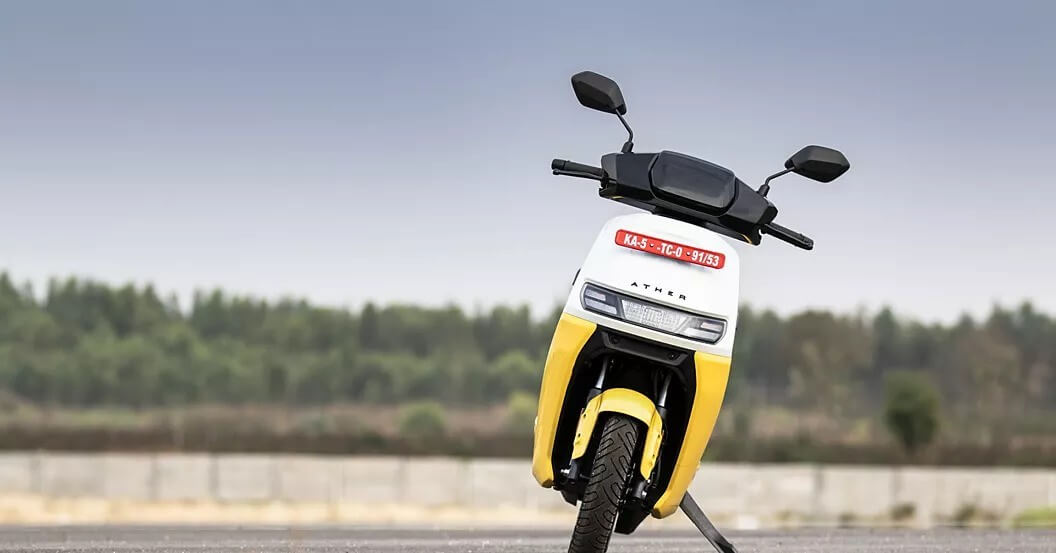
That said, the headlight setup has sparked some concern among users on the Ather Community forum, particularly about reduced visibility in cornered areas. It’s a valid point and something Ather could work on. Above that, the handlebar area remains minimalistic, save for the rear-view mirrors mounted cleanly on top.
Looking at the side profile, the boxy side panels may seem simple, but they serve a purpose. This chunkier design supports a new sub-frame that holds a significantly longer seat (900 mm). The result is not just a comfier ride for two, but also increased storage. The Under-Seat compartment holds a massive storage, and it even includes an additional 22-liter frunk up front.
From an ergonomic standpoint, the Rizta gets it right. The wide and flat floorboard comes with a non-slip texture and subtle contouring, which helps with grip and water drainage, especially during the monsoon season. And, the scooter rides on standard 12-inch Alloy Wheels with a disc brake up front and a drum brake at the rear.
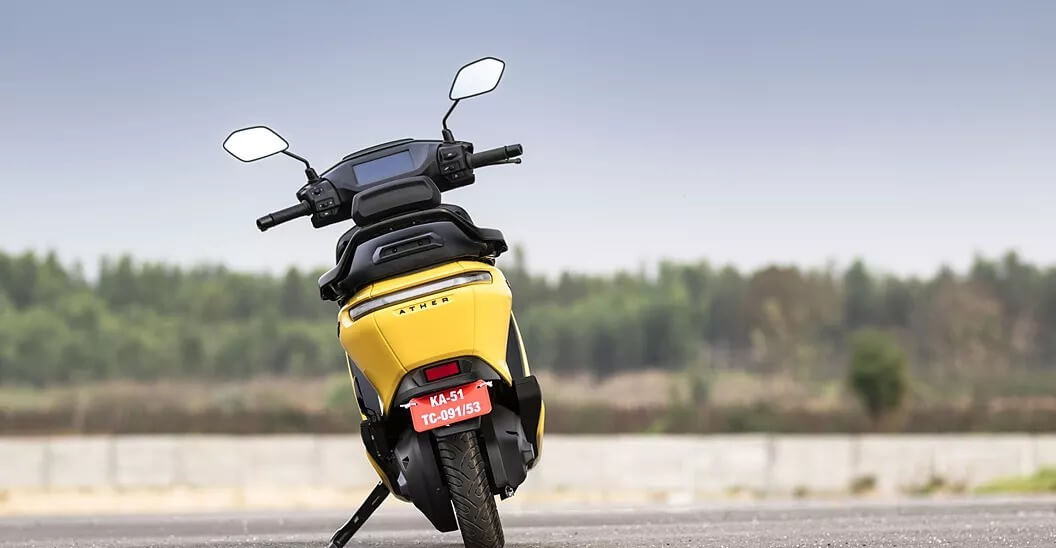
The rear design neatly mirrors the front, featuring a bar-style taillight that aligns well with the headlight’s horizontal theme. There’s also a practical backrest for the pillion, which blends well with the cushioned, wide seat. One small but thoughtful detail is the rear wheel cover on both sides, likely doubling as side mudguards.
Ather also offers a healthy splash of color options like Pangong Blue, Siachen White, and Deccan Grey. On top of that, it gets exclusive dual-tone finishes like Alphonso Yellow, Cardamom Green, and additional takes on Pangong Blue and Deccan Grey.
Instrument Cluster
On the dashboard front, Ather Rizta Z comes equipped with a 7-inch full-color TFT Touchscreen. It’s responsive, bright, and easy to navigate thanks to a 4-way joystick controller. Under the hood, it runs on a Snapdragon 212 processor with 2GB of RAM and 16GB of internal storage.
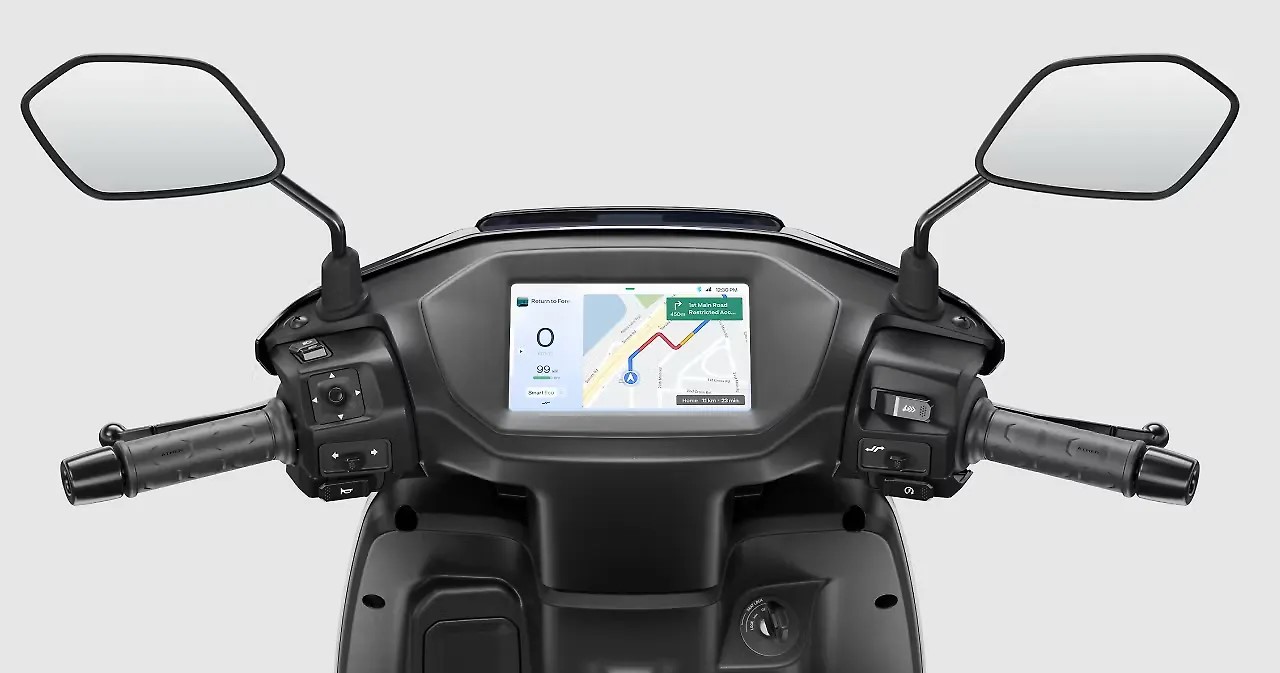
This setup comfortably supports features like Google Maps, Document Storage, App Features, Inter-City Trip Planner, Ride Stats, Live Location Sharing, and the Ping My Scooter function. It’s easily one of the most advanced dashboards in the segment.
ALSO READ: Bajaj Chetak Price in Nepal (November 2025 Updated)
Performance
The Rizta Z runs on a 4.3 kW Permanent Magnet Synchronous Motor (PMSM), which produces a max power of 5.8 PS and 22 Nm of torque. That gives it a respectable top speed of 80 kmph, which is suited for its role as a family scooter.
As mentioned earlier, it packs the larger 3.7 kWh battery, giving it an IDC-rated range of 159 km. Realistically, you’ll be looking at Ather’s claimed 125 km True Range, and based on feedback from existing owners, the real-world figure sits between 100 and 125 km per charge.
Charging is handled by the 700W Ather Duo Charger, which takes around 4 hours and 30 minutes to get from 0 to 80% and 5 hours and 45 minutes for a full charge. The Rizta also works seamlessly with Ather’s portable charger and the Ather Grid fast-charging network, adding more flexibility for day-to-day use.
Furthermore, Ather Rizta Z can be charged with both its Portable AC Charger and DC Fast Charging, which is readily available thanks to the Ather Grid Fast-charging network.
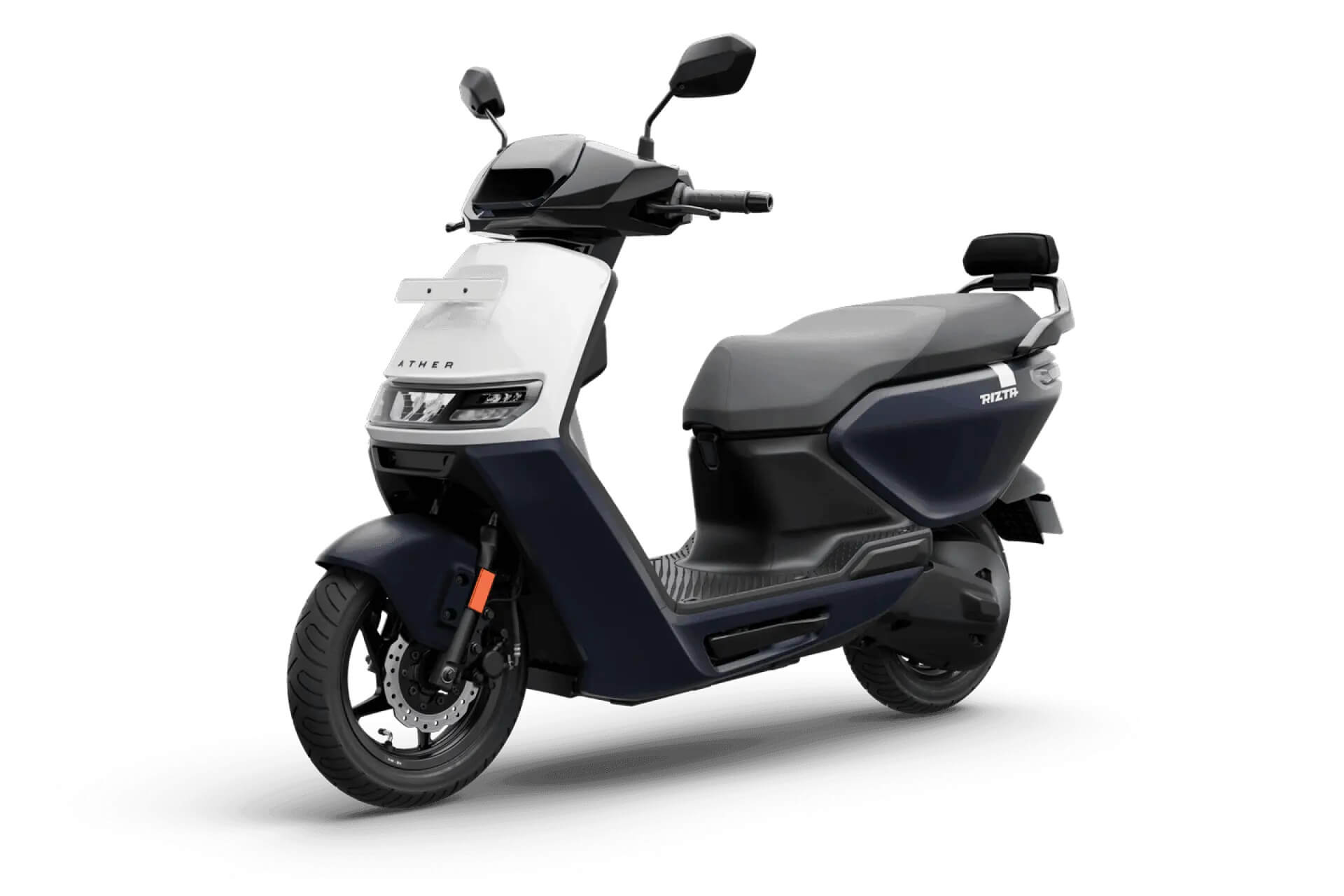
In terms of more performance-centric features, Rizta includes two riding modes: SmartEco for efficiency and Zip Mode for quicker performance. It sprints from 0 to 40 kmph in just 4.7 seconds, placing it among the quickest in the family-oriented segment. Then comes the added tech.
Rizta Z comes with Pro Pack installed by default. This unlocks a suite of extra features like Ride Assist, Ather Connect, OTA updates powered by Atherstack, and an Eight70 Battery Warranty. Buyers also get smart touches like Skid Control, AutoHold, Auto Indicator Cut-Off, FallSafe, Emergency Stop Signal, and Guide-Me-Home Lights.
However, it does not include the Magic Twist feature that is available in the Indian version. This is similar to the Ather 450X, where Ather Nepal also removed the Magic Twist feature due to its limited practical feasibility for Nepali riders.
Additional Details
The Ather Rizta comes equipped with a Telescopic Fork up front and a Rear Monoshock, handling suspension duties with a balanced approach. While this type of setup often leans towards the stiffer side, a little softer feel is obviously there to suit its family-oriented nature.
When it comes to dimensions, the Rizta stretches 1850 mm in length, 750 mm in width, and stands 1140 mm tall. It rides on a 1285 mm wheelbase.
With a ground clearance of 165 mm, it confidently handles city speed bumps and potholes, but beyond urban areas, this might not be quite up for the task. But at 125 kg of kerb weight, it feels light enough to maneuver through traffic.
One of its standout features is the seat. At 900 mm in length, it’s the longest and widest seat in the segment, offering generous comfort for both rider and pillion.
Beneath this spacious seat, Ather has integrated a massive 34-liter Under-Seat Storage compartment. This class-leading space can easily accommodate a full-face helmet, a backpack, or daily carry items with room to spare.
Ather Rizta Features Highlight
- 4.3 kW IP66 Rated Motor
- 3.7 kWh Battery pack
- SmartEco and Zip Riding Modes
- LED Headlights with Integrated DRLs
- 7-inch Color TFT Display
- 15 Degree Gradeability
- 900 mm Long Seats
- Wide Pillion Backrest
- 12-inch Alloy Wheels
- 22-liter Frunk / 34-liter Under-Seat Storage
- Skid Control
- Side Stand Sensors
- Reverse Mode
- Share Live Location
- Ping My Scooter
- Tow & Theft Alerts
- Auto Indicator Cut-Off
- Emergency Stop Signal (ESS)
- Fall Safe
- Auto Hold
ALSO READ: TVS iQube Price in Nepal (November 2025 Updated)
Ather Rizta Price in Nepal and Availability
The Ather Rizta price in Nepal is Rs. 3,83,500. Ather Nepal has kept things simple for its debut, offering only the top-spec Rizta Z in the local market.
While that pushes the price toward the higher side than initially expected, it’s a strategy we’ve seen before with the first launch of the 450X in Nepal. If demand picks up, a more affordable variant could follow later. For now, the Rizta Z sits neatly between the 450X 2.9 kWh (Rs. 3.65 Lakhs) and the 450X 3.7 kWh (Rs. 4 Lakhs).
Apart from its family-friendly styling and slightly smaller 4.3 kW motor, most of its specs and features are on par with the flagship 450X. This makes it an appealing way to get a near-flagship Ather experience without paying the full flagship price.
The following table lists the Ather Rizta Z price in Nepal for November 2025.
| Ather Rizta | Price in Nepal |
|---|---|
| Z – 3.7 kWh | Rs. 383500 |
Rivals
The Ather Rizta Z rivals the TVS iQube and Bajaj Chetak in Nepal’s growing electric scooter market.
The TVS iQube 2.2 kWh is the most affordable option in this space, but its 75 km claimed range feels disappointing. There is a higher iQube variant with a 4.4 kW motor and a 3 kWh battery priced at Rs. 4.00 lakhs. However, that variant is now two years old and simply fails to match the modern standard set by the other two. That is why the iQube steps out of the race for this comparison.
That leaves the real contest between the Ather Rizta Z and the Bajaj Chetak 3501. On paper, the similarities are striking. The Rizta’s 3.7 kWh battery and the Chetak’s 3.58 kWh pack both deliver an impressive real-world range of 110 to 125 km. Their weight is also close, with the Rizta at 125 kg and the Chetak at 129 kg. Despite the extra kilos, the Chetak compensates with its faster 950W charger, making it the quickest to fully recharge in 4 hours and 25 minutes when compared to 5 hours and 45 minutes in Rizta.
Performance follows the same theme. The Rizta uses a 4.3 kW motor, while the Chetak runs a 4 kW setup. This is reflected in the top speed, as the Rizta claims the higher top speed of 80 km/h over Chetak’s 73 km/h.
On paper, these numbers could make the Chetak look like the better value, especially when factoring in its price of Rs. 3.25 lakhs compared to the Rizta’s Rs. 3.84 lakhs. However, there is one key weakness holding the Chetak back. Its Single-Side-Leading-Link front suspension and Off-set Monoshock at the rear feel outdated. The ride quality is noticeably stiffer, bumps are not absorbed as effectively, and there is a delayed reaction that transfers more shock to the rider. Over time, this takes a toll on comfort and ride quality.
This is where the Ather Rizta pulls ahead. Its suspension is better tuned for everyday comfort. It comes with a family-focused design, featuring the longest and widest seat in the segment. Adding to this, Ather Nepal’s growing fast-charging network, strong after-sales support, and premium brand image, the higher price begins to make sense.
Bajaj could easily close the gap in the future with an updated suspension setup, but for now, the Rizta stands out as the more balanced and comfort-oriented option that justifies its premium.
What do you think about Ather Rizta? How would you feel about its price? Will it find the same success as the Ather 450X in the Nepali market? Drop your thoughts in the comments below!
Frequently Asked Questions
Who is the authorized distributor of Ather Rizta Z in Nepal?
Vaidya Energy is the authorized distributor of Ather Rizta Z in Nepal.
What is the price of the Ather Rizta Z in Nepal?
Ather Rizta Z price in Nepal is Rs. 3,83,500.
What is the ground clearance of the Ather Rizta Z?
The ground clearance of the Ather Rizta Z is 165 mm.
What is the real range of the Ather Rizta Z?
Ather Rizta Z has an IDC claimed range of 159 km and a True Range of 125 km. But, in real-world conditions, it will give a 100+ km range as well.
-
Proton Xchange for Excellence Starts Today: Biggest Price Drop on eMas 7 & Offers!HIGHLIGHTS The Proton Xchange for Excellence event is happening from 21 to 23 November 2025.…
-
Yamaha Scooters Price in Nepal (November 2025 Updated)This is the detailed price list of the Yamaha scooters in Nepal for 2025. In…
-
Moto G96 Launching Soon in Nepal: Premium Design and Better CamerasHIGHLIGHTS The Moto G96 price in Nepal is expected to start at Rs. 29,999 (8/128GB).…


